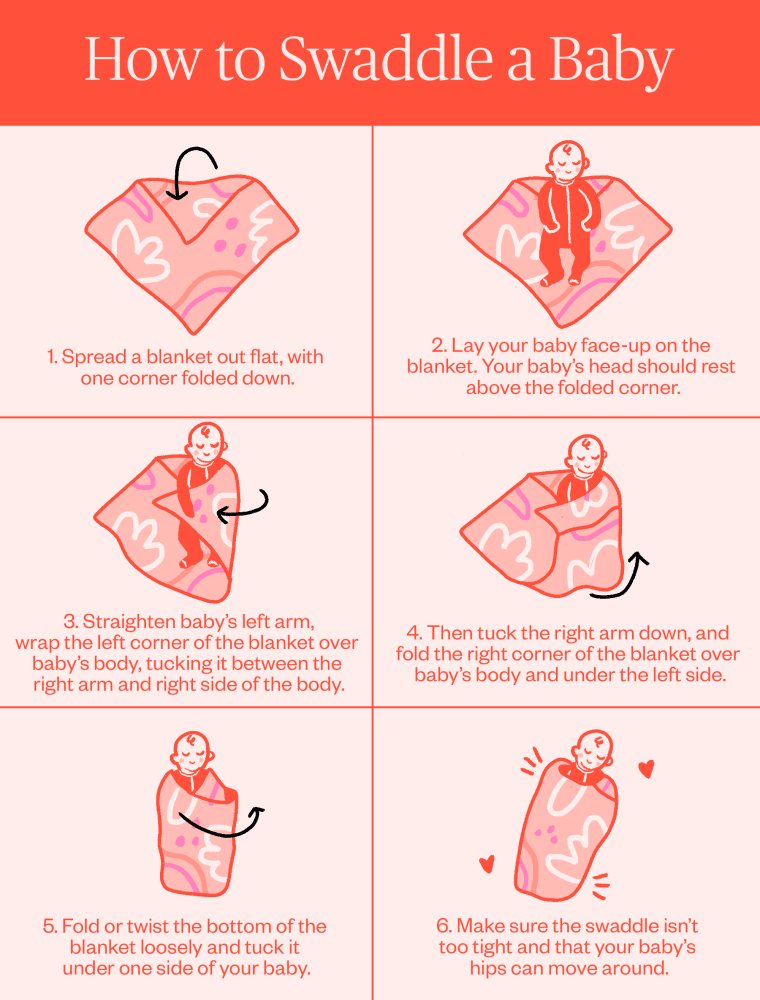As a new parent, it might have seemed strange when your newborn was brought to you swaddled — wrapped more like a burrito than a tiny baby. This centuries-old practice of wrapping a baby snugly to restrict movement of its arms and legs can be beneficial in a number of ways, but many wonder, is it safe to swaddle a baby? Here’s what you need to know about the pros and cons of swaddling, how to swaddle a baby correctly, and how to reduce your baby's risk of sudden infant death syndrome (SIDS).
Swaddling a baby pros and cons
When considering swaddling your baby and assessing safety concerns, it's important to weigh the benefits and risks. It's also reasonable to ask questions like: Is it good to swaddle a baby? How long should babies be swaddled? When and why is swaddling not recommended? Do babies sleep longer when swaddled? Are there swaddling techniques that make it safer?
Swaddle Pros
Today, many American infants, ages 0-3 months, are swaddled. Here’s how swaddling can benefit your baby:
- Helps infants feel more secure as they transition to life outside the womb. In a way, swaddling is like wearing a hug.
- Soothes and keeps the baby calm at naptime and at night.
- Keeps infants from being startled by their own Moro (or startle) reflex. Those little flailing arms can disrupt a baby’s sleep.
- Promotes longer periods of sleep. “Swaddling is not created to provide uninterrupted sleep,” Carolynne Harvey, a baby sleep consultant for 4moms and founder of Dream Baby Sleep, told TODAY Parents. “It does not have that power. Babies naturally awaken for safety measures — if they get too hot or hungry, they will wake up.”
- Keeps babies warm until the body can regulate temperature well.
Swaddling can also indirectly benefit new moms, since cozy, secure babies sleep better and cry less, which can lead to more — and better quality — sleep and less stress for moms. In many ways, swaddling creates a win-win situation, but there are some risks, too.
Swaddle cons
“One of the problems with swaddling is that it’s hard to do it absolutely right,” Michael Goodstein, MD, a neonatology physician at WellSpan Health in York, Pennsylvania, and director of the York County chapter of Cribs for Kids, told TODAY Parents. “It’s like baby origami.”
Because getting the baby wrapped correctly in a swaddle can be difficult, parents and caregivers may end up swaddling their babies in ways that do more harm than good. Incorrect swaddling can lead to:
- Hip dysplasia: If babies are swaddled too tightly around the hips, they could develop hip joint issues, including dysplasia, according to experts. In the first six months, a baby’s legs need to be flexed and separated; they shouldn’t be restricted and forced to extend straight.
- Trouble breathing: Babies swaddled too tightly around the chest may not be able to breathe deeply enough. Leave about two or three fingers-width between the baby’s chest and the swaddle.
- Suffocation hazards: If swaddled too loosely, a baby could kick out of the swaddle, leaving a loose blanket in the crib — and that increases the risk of suffocation and choking.
It’s also important to make sure swaddled babies do not get overheated, since this raises the risk of SIDS. Signs of overheating include:
- Sweating
- Damp hair
- Rapid breathing
- Flushed cheeks
A good rule is to dress your baby in one layer more than you’re comfortable wearing.
Babies need to be monitored while they sleep to make sure they don’t accidentally roll over. When swaddled babies are put to sleep on their stomachs — or if they roll onto their stomachs while they sleep — their risk of SIDS is 20 times greater than for non-swaddled babies. That’s because they can’t use their arms or legs to get out of danger. When babies show signs of starting to roll over (usually around two months old), it’s time to stop swaddling.
How to swaddle a baby — step by step
These steps can help you swaddle your baby correctly, according to the American Academy of Pediatrics. Check out our infographic to find out how to swaddle a baby.

Swaddle tips
There are different ways to swaddle a baby. In fact, it’s not even necessary to swaddle the entire body. You can swaddle only the baby’s arms and leave the legs free to move. Additionally, instead of using a blanket, you can try products like the Ollie Swaddle or swaddles with Velcro fasteners or snaps that make it simple to swaddle correctly. Another option is a sleep sack, which provides the snug feeling of a swaddle without all the hassle. Sleep sacks can be helpful if your baby has trouble transitioning to sleeping without a swaddle.
What about tummy time for babies?
All babies need some tummy time every day. Being on the tummy helps babies develop head and neck control as well as core muscles, explained Harvey. “Do tummy time from day one, one minute three times a day, fully supported,” she said. “That is, place baby on your chest. Then, when baby is able to arch his back and lift his head and neck, transition to tummy time on the floor. Your pediatrician can advise you on the right time to do this, but it’s usually when baby’s around two to three weeks old.”
Harvey recommended adding a minute to each session for every week of age based on your baby’s due date. That means that by the time your baby is 15 weeks old — or is 15 weeks post due date — he should be having 15 minutes of tummy time, three times a day. Tummy time helps prevent SIDS by strengthening muscles that allow babies to move their head if they get caught against a stuffed toy, bumper, mattress or something else.
Should infants in child care centers be swaddled?
The AAP recommends that infants not be placed in child care centers until they are about three months old. By then, infants are no longer being swaddled, so the risks associated with swaddling aren’t a concern.
Swaddling is not recommended for infants younger than two months who are placed in childcare. Variations in swaddling techniques by the different caregivers and the inability of caregivers to monitor the infant adequately if it accidentally rolls over while swaddled are among the main reasons.
Swaddling and SIDS
According to the AAP, swaddling may help calm fussy infants, but there is no evidence that swaddling reduces the risk of SIDS. There are, however, other things you can do. Here are four ways to lower your baby’s risk of SIDS.
- Follow the AAP’s safe sleep guidelines. The AAP recommends placing babies on their backs in a crib near your bed without any bedding (other than a fitted sheet) or soft objects.
- Consider using a pacifier. The AAP endorses giving babies a pacifier when it’s time for sleep. (One-piece pacifiers are recommended.) Not only can a pacifier soothe your baby, said Dr. Goodstein, “there’s a very strong correlation in the use of a pacifier and a decreased incidence of SIDS.” If the pacifier falls out of your baby’s mouth during sleep, it’s not necessary to put it back in.
- Breastfeed. Breastfeeding may reduce the risk of SIDS, according to a meta-analysis of studies published in November 2017 in the AAP journal Pediatrics. Researchers found that breastfeeding for at least two months can lower the risk of SIDS by nearly 50%. Goodstein also pointed out that breastfeeding for six months may reduce SIDS risk by up to 65%.
- Maintain a smoke-free environment. Always keep your baby — whether sleeping or awake — in smoke-free areas. Exposure to secondhand smoke in the household can double a baby’s risk of SIDS, according to the National Institute of Child Health and Human Development. The risk of SIDS also more than doubles for babies with mothers who smoked during pregnancy compared to those with mothers who didn’t smoke while they were pregnant, according to a study published in April 2019 in Pediatrics.




